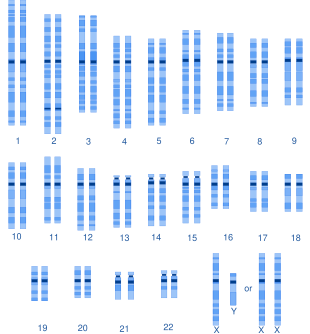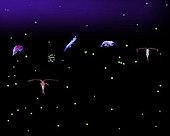Genetic diversity
According to the lead researcher in the study, Dr. Richard Lankau, "If any one type is removed from the system, the cycle can break down, and the community becomes dominated by a single species.
[2] Loss of genetic diversity in domestic animal populations has also been studied and attributed to the extension of markets and economic globalization.
[7] It may be possible to identify adaptive genes through genome-wide association studies by analyzing genomic data at the population level.
[10] In a review of current research, Teixeira and Huber (2021), discovered some species, such as those in the genus Arabidopsis, appear to have high adaptive potential despite suffering from low genetic diversity overall due to severe bottlenecks.
[11] Small populations are more likely to experience the loss of diversity over time by random chance, which is an example of genetic drift.
[21] When humans initially started farming, they used selective breeding to pass on desirable traits of the crops while omitting the undesirable ones.
Selective breeding leads to monocultures: entire farms of nearly genetically identical plants.
Little to no genetic diversity makes crops extremely susceptible to widespread disease; bacteria morph and change constantly and when a disease-causing bacterium changes to attack a specific genetic variation, it can easily wipe out vast quantities of the species.
If the genetic variation that the bacterium is best at attacking happens to be that which humans have selectively bred to use for harvest, the entire crop will be wiped out.
They planted namely the "lumper" variety of potato, which was susceptible to a rot-causing oomycete called Phytophthora infestans.
[23] The fungus destroyed the vast majority of the potato crop, and left one million people to starve to death.
It provides the raw material for selective breeding programmes and allows livestock populations to adapt as environmental conditions change.
[29] Livestock biodiversity can be lost as a result of breed extinctions and other forms of genetic erosion.
As of June 2014, among the 8,774 breeds recorded in the Domestic Animal Diversity Information System (DAD-IS), operated by the Food and Agriculture Organization of the United Nations (FAO), 17 percent were classified as being at risk of extinction and 7 percent already extinct.
FAO has published two reports on the state of the world's animal genetic resources for food and agriculture, which cover detailed analyses of our global livestock diversity and ability to manage and conserve them.
For example, malaria vaccinations are impacted by high levels of genetic diversity in the protein antigens.
[30] In addition, HIV-1 genetic diversity limits the use of currently available viral load and resistance tests.
[32] For example, the sequencing of 86 SARS-CoV-2 coronavirus samples obtained from infected patients revealed 93 mutations indicating the presence of considerable genetic diversity.
[34] This process which also generates genetic diversity appears to be an adaptation for coping with RNA genome damage.
This constant shift of genetic makeup helps to maintain a healthy population of plankton despite complex and unpredictable environmental changes.
Low genetic diversity and resulting poor sperm quality has made breeding and survivorship difficult for cheetahs.
They undergo induced ovulation, which means that a new egg is produced every time a female mates.
By mating with multiple males, the mother increases the genetic diversity within a single litter of cubs.
[39] Creating or maintaining high genetic diversity is an important consideration in species rescue efforts, in order to ensure the longevity of a population.



